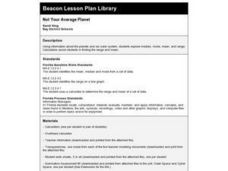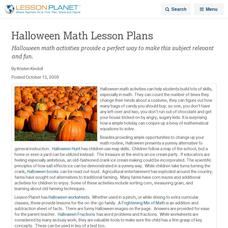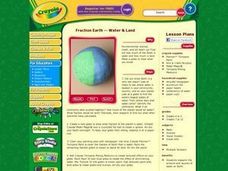Curated OER
Planets Beyond
Students recognize basic geometric shapes. They research the positions of planets in our solar system and find information on early theories about the location of planets and the sun. Students visualize planets as they might appear in an...
Curated OER
Making Models of the Solar System
Learners make several models of the solar system to learn the positions of the planets in the solar system as well as relative distances and sizes. Creation of these models will help them identify the planets by size, shape, color,...
Education Outside
Our Water Planet
Fresh water is a precious resource. Most kids don't realize how little of the water on Earth is actually drinkable. This lesson will help to illuminate them on this important topic. They discus the ratio of water to land, where most...
Curated OER
Metallic Galactic Mobile
Learners create 3-dimensional models of their own imaginary galaxies of newly discovered planets. They write fictional accounts of their experiences visiting each new planet. Students writing includes a recognizable beginning, middle,...
Curated OER
The Drake Equation
Learners use the Drake Equation to calculate the probability of sustaining life on various planets. Through the use of the equation, they determine whether intelligent and advanced civilizations can be developed on planets other than...
Curated OER
Meet the Neighbors: Planets Around Nearby Stars
Students explain why a transiting planet causes a periodic dimming in the light from its parent star. They determine the radius of a planet, and its orbital distance, by analyzing data and manipulating equations. Students compare the...
Curated OER
Not Your Average Planet
Fourth graders explore median, mode, mean, and range using information about the planets and our solar system.
EngageNY
Operations with Numbers in Scientific Notation
Demonstrate the use of scientific notation within word problems. The lesson presents problems with large numbers best represented with scientific notation. Pupils use these numbers to solve the problems in the 11th installment in a...
Groundwater Foundation
How Wet Is Our Planet?
Here's a powerful demonstration that makes the point that it is everyone's responsibility to conserve water and protect the earth's limited supply of fresh water.
Texas Instruments
TI-Nspire™ CAS
When it comes to rating educational calculators, this calculator is always near the top of this list. Now it's available as an app. There is a lot of calculator power wrapped up in this app. Not only is this a fully functioning...
Texas Instruments
TI-Nspire™
We landed on the moon with less computing capabilities than you can find in this app! Here is a multiple function calculator that takes all the power you get from a handheld and adds the wonderful large screen that only a tablet can...
Curated OER
Global Warming and Climate Change
Students explore the environment by writing a persuasive letter. In this global warming lesson plan, students identify the key problems with our energy consumption in the United States. Students complete worksheets and write a letter...
Curated OER
Reading Venn Diagrams
Venn diagrams are useful in so many ways. The class views a worksheet to assist them in understanding how to compare two items based on similarities and differences. Children compare four different items using partially completed Venn...
Curated OER
Halloween Math Lesson Plans
Halloween math activities provide a perfect way to make this subject relevant and fun.
Curated OER
Developing the Concept: Proportions
Learners solve problems with proportions. In this proportions lesson, students solve word problems as they learn about how to set up formulas for solving proportions. Learners then solve problems using proportions.
Curated OER
Golf and Divorce
There seems to be an interesting relationship between the increasing numbers of golf courses and divorce. Assess student understanding of correlation and causation by asking them to explain what it is. Use this short activity as a class...
Curated OER
Fraction Earth -- Water and Land
Students research the amount and sources of water on Earth. They interpret data to create a physical representation of water and land mass on the planet. They then use art materials to create a visual and tactile representation of...
Houghton Mifflin Harcourt
Math Skiils: Comparing Integers on a Number Line
Here is an attractive assignment that instructs learners how to compare more than one integer on a number line. After the lesson, three practice problems follow. They require learners to place integers on a number line and then order...
Curated OER
Clip the Face
Learners discover the moon's phases and the rarity of eclipses. In this lunar lesson, students view a video titled Spin Around the Solar System: A Moon Dance, which demonstrates the key differences between a lunar and solar eclipse....
Curated OER
The Ancient Maya
Students explore the culture of the Mayans through a variety of activities. In this lesson about Maya, students analyze pictures in books and on websites, produce scale models of Maya architecture, and create Maya mosaics. Students study...
Curated OER
Pick a Pet
Students construct a pictograph of favorite pets. In this pets and graphing lesson, students discuss their favorite pet and use animal magazines to find their favorite pets and cut them out. Students create a pictograph using the pictures.
EngageNY
The Motion of the Moon, Sun, and Stars—Motivating Mathematics
What does math have to do with the behavior of the earth and sun? Learn how the movement of celestial bodies has influenced the development of trigonometry. Scholars connects the details in mathematics to their...
Curated OER
What is Matter?
Young scholars investigate what matter is and how it changes states. In this physical properties lesson plan, students examine the vocabulary database and identify the characteristics of the three phases of matter. Young...
Curated OER
On Jupiter
Young scholars tour Jupiter. In this scenario based instructional activity, students examine the size of Jupiter and make models of the other planets in the solar system to show how large Jupiter is compared to the other planets.























